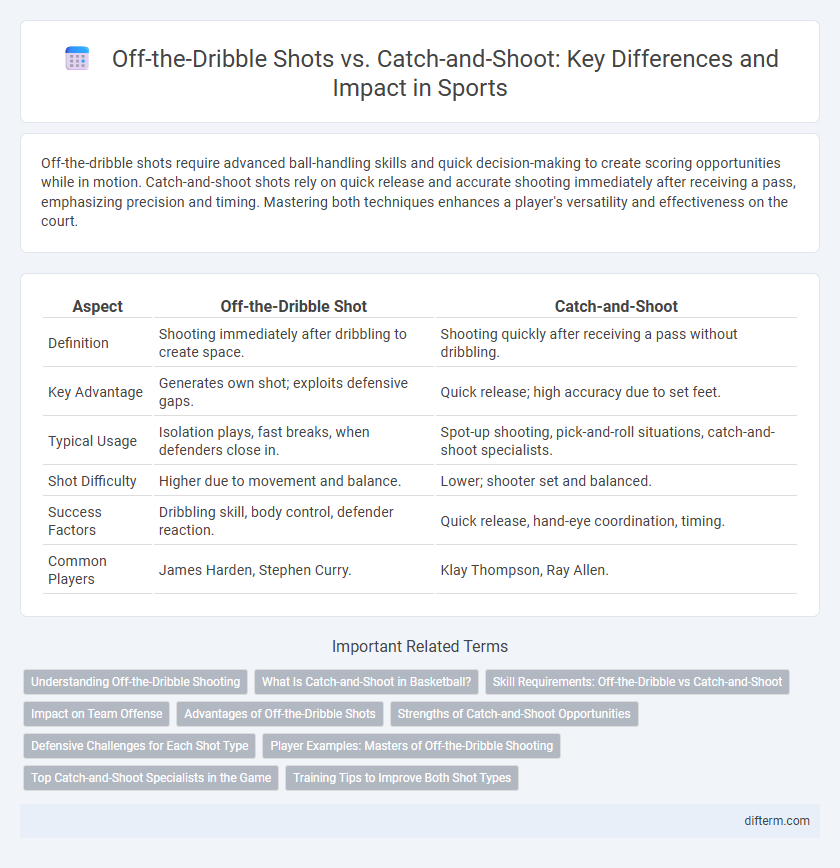Off-the-dribble shots require advanced ball-handling skills and quick decision-making to create scoring opportunities while in motion. Catch-and-shoot shots rely on quick release and accurate shooting immediately after receiving a pass, emphasizing precision and timing. Mastering both techniques enhances a player's versatility and effectiveness on the court.
Table of Comparison
| Aspect | Off-the-Dribble Shot | Catch-and-Shoot |
|---|---|---|
| Definition | Shooting immediately after dribbling to create space. | Shooting quickly after receiving a pass without dribbling. |
| Key Advantage | Generates own shot; exploits defensive gaps. | Quick release; high accuracy due to set feet. |
| Typical Usage | Isolation plays, fast breaks, when defenders close in. | Spot-up shooting, pick-and-roll situations, catch-and-shoot specialists. |
| Shot Difficulty | Higher due to movement and balance. | Lower; shooter set and balanced. |
| Success Factors | Dribbling skill, body control, defender reaction. | Quick release, hand-eye coordination, timing. |
| Common Players | James Harden, Stephen Curry. | Klay Thompson, Ray Allen. |
Understanding Off-the-Dribble Shooting
Off-the-dribble shooting requires precise ball control, footwork, and the ability to create space from defenders while maintaining balance for accurate release. This skill elevates a player's offensive versatility by enabling scoring opportunities beyond catch-and-shoot scenarios, often forcing defensive adjustments. Mastery of off-the-dribble shots increases effectiveness in transition plays and isolation sets, critical for dynamic offensive strategies in basketball.
What Is Catch-and-Shoot in Basketball?
Catch-and-shoot in basketball is a technique where a player receives a pass, quickly sets their feet, and shoots the ball without dribbling. This skill relies heavily on timing, quick release, and accuracy, often creating open shots from beyond the three-point line. Efficient catch-and-shoot players help maintain offensive flow by capitalizing on rapid ball movement and defensive lapses.
Skill Requirements: Off-the-Dribble vs Catch-and-Shoot
Off-the-dribble shots demand advanced ball-handling skills, allowing players to create space and adjust their shooting angles dynamically. Catch-and-shoot techniques prioritize quick release and precision, relying heavily on timing and positioning after receiving a pass. Mastery of off-the-dribble shots enhances scoring versatility, while proficiency in catch-and-shoot contributes to efficient offensive plays and floor spacing.
Impact on Team Offense
Off-the-dribble shooting enhances team offense by creating dynamic scoring opportunities and breaking down defensive setups through ball movement and player agility. Catch-and-shoot proficiency improves offensive efficiency by enabling quick, accurate shots that exploit defensive lapses and maintain offensive rhythm. Combining both skills diversifies offensive strategies, increasing unpredictability and spacing on the floor.
Advantages of Off-the-Dribble Shots
Off-the-dribble shots offer basketball players enhanced offensive versatility by enabling dynamic movement and creating scoring opportunities even with tight defense. This skill allows shooters to maintain offensive rhythm and exploit gaps in the opponent's defense by generating their own shot rather than relying on set plays. The ability to shoot off the dribble increases a player's threat range, making it harder for defenders to predict and react effectively.
Strengths of Catch-and-Shoot Opportunities
Catch-and-shoot opportunities excel in basketball due to their quick release, allowing players to capitalize on open looks before defenders can react. This shooting style is highly efficient in spaced offenses, as it takes advantage of ball movement and off-ball screens to create uncontested shots. Teams leveraging catch-and-shoot tactics often see higher shooting percentages and better floor spacing, enhancing overall offensive flow.
Defensive Challenges for Each Shot Type
Off-the-dribble shots force defenders to react dynamically to ball handler movements, increasing the difficulty of maintaining close coverage and contesting the shot effectively. Catch-and-shoot scenarios allow defenders to anticipate and close out quickly, but require precise timing and footwork to avoid fouls and maintain balance. Defensive strategies must adapt to the fluidity of off-the-dribble attempts versus the rapid close-out demands in catch-and-shoot situations.
Player Examples: Masters of Off-the-Dribble Shooting
Stephen Curry, renowned for his unparalleled off-the-dribble shooting, consistently creates space with his quick handles and deep range, making him a master of scoring on the move. James Harden's ability to break down defenders with step-back threes highlights the effectiveness of off-the-dribble shooting in generating high-percentage shots under pressure. Damian Lillard combines speed and precision off the dribble, often pulling up from beyond the arc with exceptional clutch performance, exemplifying elite off-the-dribble scoring prowess.
Top Catch-and-Shoot Specialists in the Game
Top catch-and-shoot specialists in basketball, such as Stephen Curry, Klay Thompson, and Joe Harris, excel at quickly receiving the ball and releasing accurate perimeter shots with minimal dribbling. Their ability to create space through screens and maintain shooting rhythm allows them to consistently score from beyond the arc under defensive pressure. These players' quick release and high shooting percentages make catch-and-shoot scenarios a crucial part of modern offensive strategies.
Training Tips to Improve Both Shot Types
To improve off-the-dribble shooting, focus on strengthening footwork, balance, and quick release through repetitive dribbling drills combined with shooting under defensive pressure. Catch-and-shoot accuracy benefits from consistent muscle memory training, including spot shooting and varying release points to simulate game scenarios. Incorporating video analysis and shooting mechanics feedback accelerates development for both shot types by identifying and correcting flaws.
Off-the-dribble shot vs catch-and-shoot Infographic

 difterm.com
difterm.com